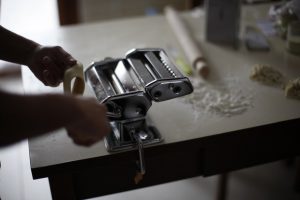 As the first piece in a larger series about maker movements around the world, we want to take a moment and talk about the big question: What is Maker Culture? In its simplest definition, this culture is one meant to reignite the artisan spirit. It pulls communities of any career or skill level into making something with their very own hands, from calligraphy to furniture to technology. There is an emphasis on learning-through-doing by using the cookbook-esque step-by-step instructions with photos.
As the first piece in a larger series about maker movements around the world, we want to take a moment and talk about the big question: What is Maker Culture? In its simplest definition, this culture is one meant to reignite the artisan spirit. It pulls communities of any career or skill level into making something with their very own hands, from calligraphy to furniture to technology. There is an emphasis on learning-through-doing by using the cookbook-esque step-by-step instructions with photos.
Maker Culture and the movement around it is thought to be a reaction to the disconnect within the physical world in cities. To simplify this, Maker Culture has been created as a bridge to pull communities back into sharing and face-to-face interaction as people help one another. Another idea of why Maker Culture is significant is because of millennials. This generation wasn’t necessarily required to take a woodshop or home economics class and may have work-oriented parents who were not likely to pass on these important skills. Therefore, millennials take to the internet to teach cooking, crafting, building, and many more maker skills as they start to build homes and families.

Maker Culture which can also be called Do-It-Yourself Culture (DIY Culture), and speaks to the very informal, highly networked, peer-lead movement of sharing skills. This contains trades as well as simple or detailed crafts that you might not have the supplies or skills to craft at home or by yourself. With the movement starting within more condensed places like cities, you can see the need (and space to utilize) power tools and various other technologies, has rapidly declined. This has sparked those deeply engaged in the maker movement to set up places known as Open Source Hardware Shops where someone can come in and work with materials that they might not have space or money for.
Some of the popular fields that are addressed within Maker Culture are art, metal-working and jewelry making, calligraphy, filmmaking, website making and design, and technology. Products that are produced within these communities have a focus on sustainable development, helping the environment, and improving the local culture. Sometimes, these groups of Makers set out to improve the community through art installations or collections. The movement can be seen in classrooms, offices, elderly homes, and much more.
 Maker Culture is taking off worldwide. Created to address a need to get our hands dirty and pull together as a community, it is benefitting the world in many different ways. By attending group events in a close city, checking out a DIY project online, or reaching out to share your skills; you are not only be adding to this amazing culture and movement, but you are be learning and improving your personal skills as well.
Maker Culture is taking off worldwide. Created to address a need to get our hands dirty and pull together as a community, it is benefitting the world in many different ways. By attending group events in a close city, checking out a DIY project online, or reaching out to share your skills; you are not only be adding to this amazing culture and movement, but you are be learning and improving your personal skills as well.




